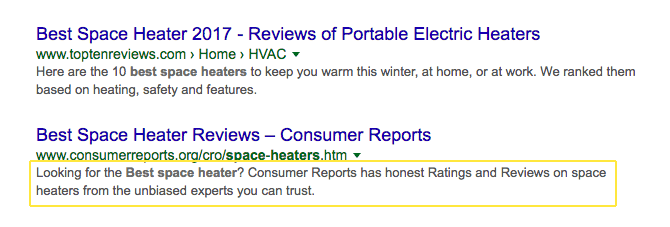The Meta description is part of meta tags. Meta tags are HTML elements that provide information about a web page for search engines and website visitors. There are two elements that must be placed as tags in the <head> section of an HTML document. These elements are title tag and Meta description.
The title tag is quite straightforward, which is the main title of the web page. Whereas the meta description is the short paragraph of text placed in the HTML of a web page that describes its content. The meta description will then appear under page’s URL in the search results. Known as a snippet, the meta descriptions are HTML attributes that provide concise summaries of web pages. They commonly appear underneath the blue clickable links in a search engine results page (SERP).

https://premium.wpmudev.org/
Generally, meta descriptions can be any length, and the search engines generally truncate snippets longer than 160 characters. It is best to keep meta descriptions long enough that they’re sufficiently descriptive but shorter than that 160-character limit.
Why do we need to carefully pay attention to meta description? A meta description can influence the decision of the searcher as to whether they want to click through on your content from search results or not. The more descriptive, attractive and relevant the description, the more likely someone will click through. Even though meta description tags, while not tied to search engine rankings, are extremely important in gaining user click-through from SERPs.
A page’s meta description should cleverly utilize the keywords that page is targeting, but also create a convincing explanation that a searcher will want to click. It should be straight and relevant to the page it describes, and unique from the descriptions for other pages.
How to write a great meta description? You need to at least follow the meta description checklist as follows.
- Write legible, readable copy
This is a vital thing to do. Keyword stuffing in meta description is bad. In fact, it doesn’t help the searcher as they’ll assume the result leads to a spammy website. Make sure the description reads like a normal, human-written sentence.
- Keywords
It is advisable to make sure most important keywords for the web page show up in the meta description. Often search engines will highlight in bold where it finds the searchers query in the snippet.
- Do not duplicate meta descriptions
As with title tags, the meta descriptions must be written differently for every page. For your information, Google may penalise for mass duplicating the meta descriptions.
- Treat the meta description as an advert for the web page
It is advisable to make it as compelling and as relevant as possible. The description must suitable with the content on the page, and at the same time make it as appealing as possible.
- Length
A meta description should be no longer than 135 – 160 characters long. Recently Google has been testing longer snippets, but better stick to the range mentioned. There is a risk that longer description will be chopped off, so make sure any important keywords are nearer the front.
- Consider using rich snippets
By using schema markup, it is advisable to add elements to the snippets to increase their appeal. For instance, by using star ratings, customer ratings, product information, calorie counts and other relevant information.






